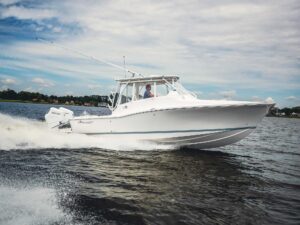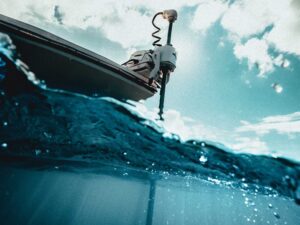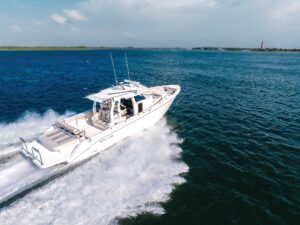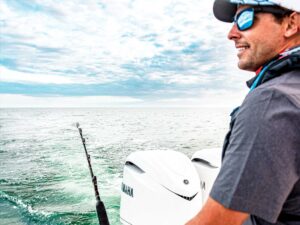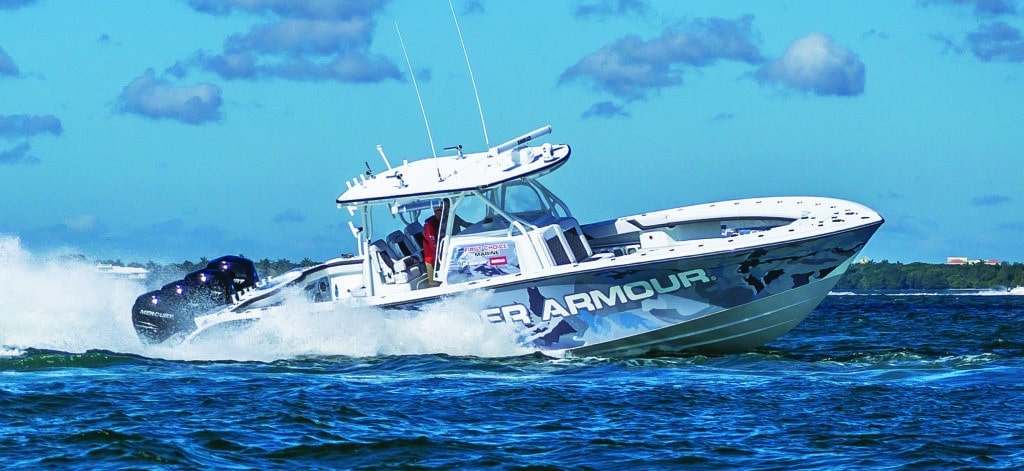
Carbon 39 from Yellowfin Yachts
The tournament director’s voice crackled over the VHF: “You can go now.” With that, a fleet of more than 50 center-consoles streaked from the jetty mouth, outboards barking and white water flying as each captain pinned the throttles en route to his chosen fishing area.
The 2016 Stock Island Village Marina King Mackerel Tournament in Key West, Florida, had finally started, reduced to a single day of fishing due to January gale-force winds that had buffeted the Keys for three days prior. I braced for acceleration aboard the Under Armour fishing team’s new Yellowfin Yachts Carbon 39, powered by four Mercury 350 hp Verado outboards and captained by Arik Bergerman.
“Jim, we’re going to hang back and let the field thin out,” said Bergerman. “But don’t worry, we’re going to beat them all.” Our destination lay 88 miles away, near the Dry Tortugas.
Though gale flags no longer flew, offshore seas still piled high, and Bergerman had no intention of taking it slow.
“I’m telling you now, it’s going to be rough, and I’m going fast,” he warned me. “I’m not turning around for anyone.” The event represented the first tournament outing for Yellowfin’s Carbon 39, making this a Fish Trial by fire.
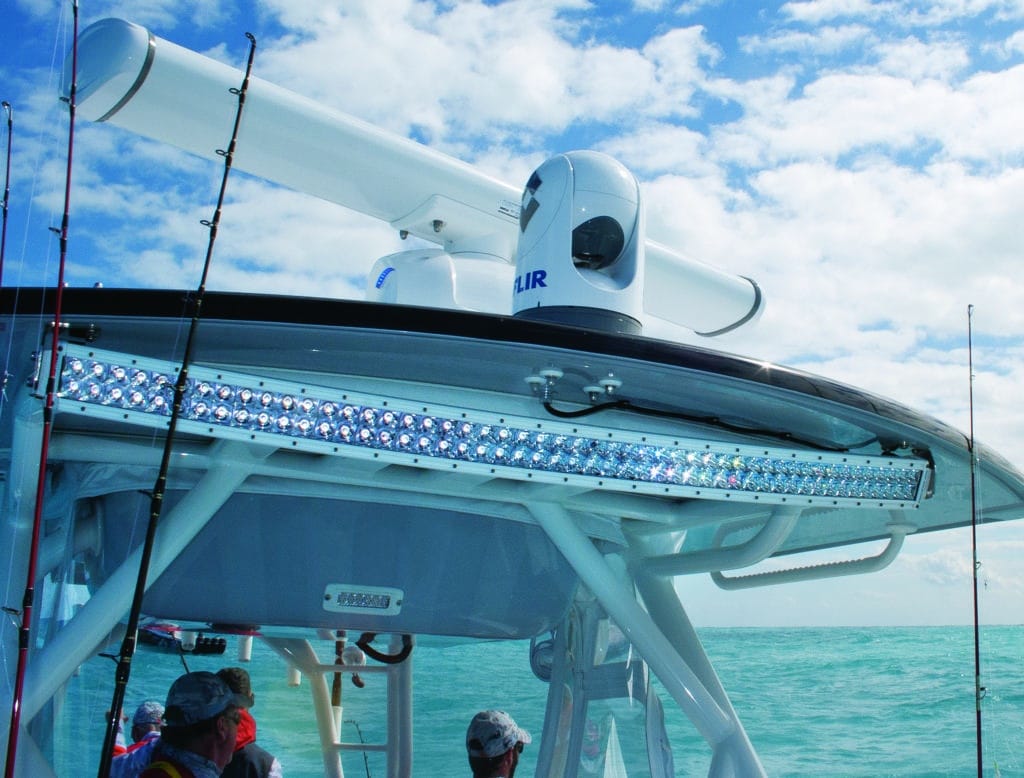
Well Equipped for Night Runs
High-Tech Hull
The 39 has occupied a position in the Yellowfin lineup since 2011, but this new iteration is different. Lightweight, super-strong carbon fiber replaces much of the fiberglass, saving approximately 2,400 pounds in weight to help boost speed and fuel efficiency.
Having shed more than a ton (roughly 18.5 percent of the original dry weight), the Under Armour boat sits noticeably high in the water. When the time came to blast off, I could also sense that the hull lifted easily, despite a crew of seven, a heavy load of fuel and ice, and full livewells.
Running in the lee of the scattered keys that extend west to the Marquesas helped smooth out the first 20 miles. The twin-stepped hull easily bridged the two- to three-foot waves as the Verado 350s pushed the Yellowfin well into the 50 mph range.
Yet the sea changed its demeanor in open water. Six- to eight-foot waves rolled in from the north. Bergerman worked the throttles to run fast between peaks, backing off slightly as we crested waves to ease the landings. Though we dropped into a few big troughs, the ride overall proved remarkably soft.
Three-across helm seats with flip-up bolsters and a contoured coaming pad at knee level on the console allowed three of the crew to stand up while underway. A clear acrylic windshield with angled side curtains blocked the wind and errant spray.
The rest of the crew hunkered down in beanbags aft. A full complement of electronics, including a new Simrad Halo 4 radar — accessed via a pair of Simrad multifunction displays flush-mounted on the 42-inch-wide helm panel — helped guide the way. About two hours and 15 minutes after leaving the jetty, we arrived at our spot, having put astern all boats that left before us.
Lightweight, super-strong carbon fiber replaces much of the fiberglass, saving approximately 2,400 pounds in weight to help boost speed and fuel efficiency.
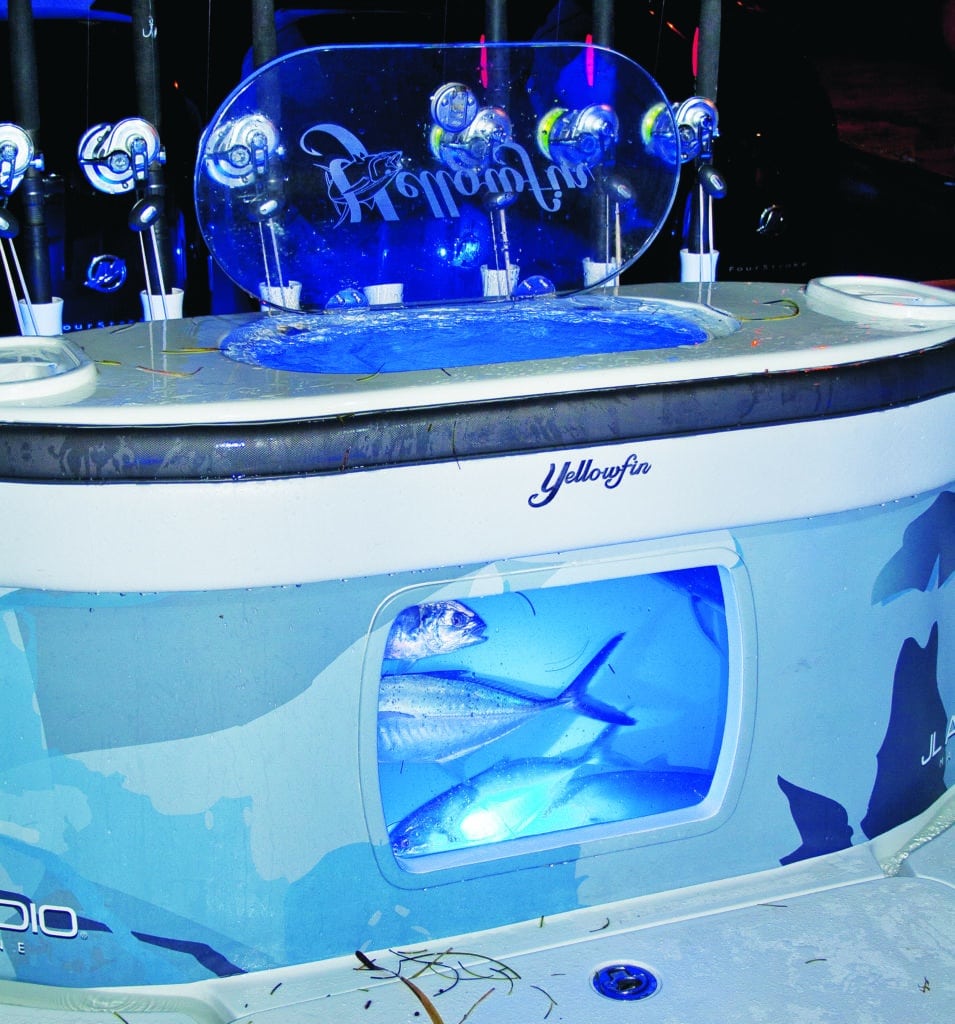
Loads of Live Bait
Beaucoup Bait
Live bait is the name of the game on the kingfish circuit, and this Yellowfin boasts capacity in spades. Three livewells — an 80-gallon tank with a viewing window in the transom, a 50-gallon well under the aft cockpit sole, and a 19-gallon livewell under the bench seat abaft the helm seating — allowed the UA fishing team to separate bait species, putting blue runners in the transom, goggle-eyes under the deck, and speedos under the seat.
In addition, four tuna tubes integrate into the transom and stern quarters. A system of eight livewell pumps, fed by a sea chest to avoid air locks and controlled by valves, allows the team members to switch pumps and keep the water flowing to all wells in case of a malfunction. Bergerman also equipped the boat with a pair of 65-quart Yeti coolers, one on each side of the aft swim platform, for icing dead baits.
The Carbon 39 abounds with rod holders, including 17 gunwale rod holders on each side, plus one at the bow and six across the transom. A rack of seven holders hangs behind the 27-inch-high transom, and 10 holders mount along the aft hardtop support. A pair of Cannon downriggers with stainless-steel bases allows the team to fish deep. Taco Marine outriggers help to increase the spread.
This tournament, however, allowed only six lines, so the crew set three flat lines, two downrigger lines and one kite line. Co-captain Randy Keys took the helm, shutting down two outboards and running the others at dead idle for a trolling speed of about 2 mph.
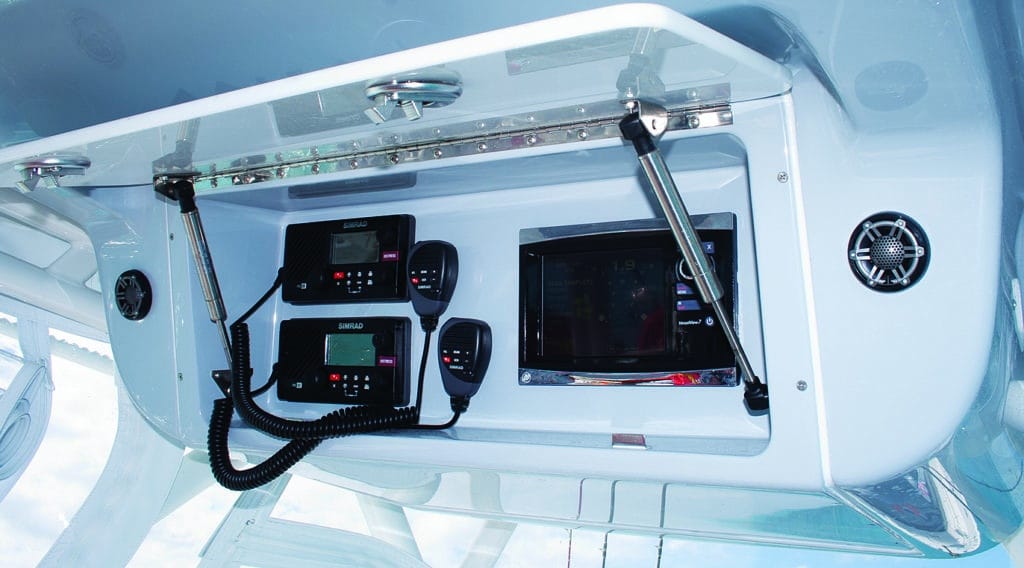
Anyway You Want It
Custom Touches
As we worked the 105-foot-deep area of live bottom, I had a chance to check out more attributes of this Yellowfin, including the stability afforded by the 11½-foot beam. The grit-style nonskid on the single-level deck offered great traction, while recessed grab rails along the 32-inch-high gunwales in the bow provided an extra measure of security.
This 39 also featured an optional pod lounge, located where you might normally find a coffin box. We used the compartment beneath to stow camera bags, dry goods and gear. Atop is a 5-by-4-foot upholstered lounger. The entire pod tilts upward at the push of a button to give access to a below-deck compartment, where the team stowed the ice-packed kill bag until needed. Additional ice was standing by in four cavernous in-sole fish lockers, two forward and two aft.
With no bites after an hour, Bergerman moved 11 miles to the east, and it paid off, first with two kingfish in the 25-pound range. Yet the team would need a bigger one to place near the top.
Then it happened. A true smoker inhaled a ribbonfish trolled on one of the downriggers. Anticipation built as team member Seth Funt worked his way to the bow and skillfully battled the kingfish, while his brother Jordan extracted the gaff from the undergunwale rod racks.
“It’s a nice one!” yelled Jordan as he reached out to gaff the big mackerel and swung it aboard. The crew swiftly transferred the fish to the kill bag and exchanged high-fives.
At the weigh-in later in the day, that 39.81-pound fish would earn the UA fishing team second place overall and first place in the pro division — a testament to the dedication of the crew and the capability of the Yellowfin Carbon 39.
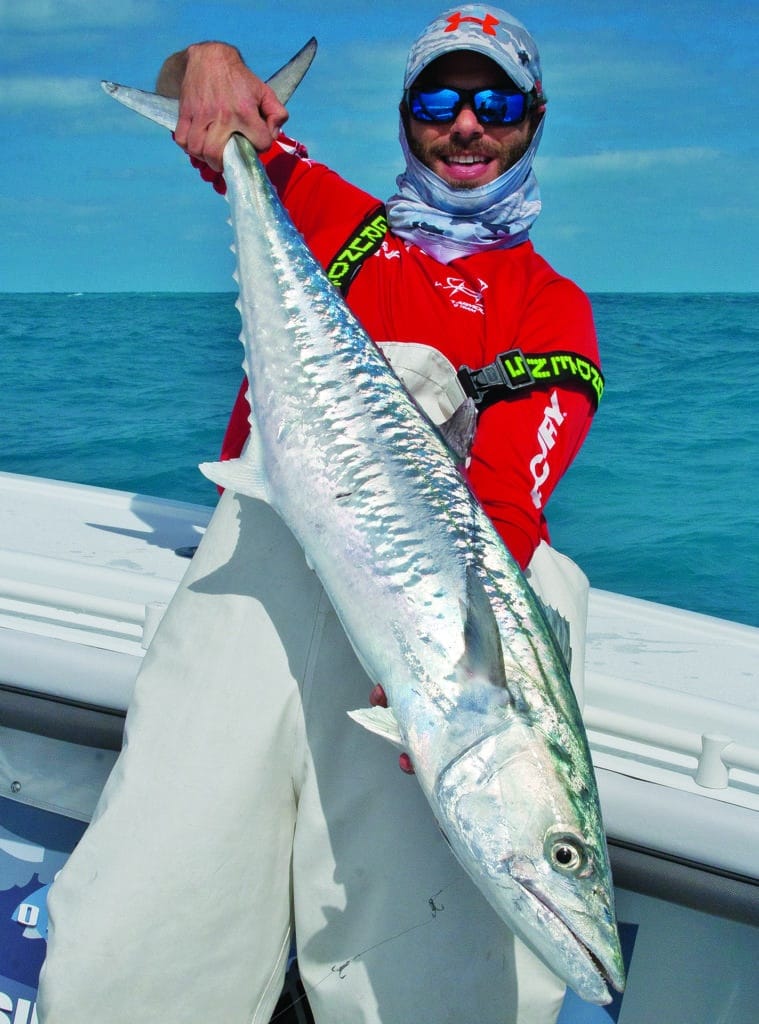
Royal Success
Fast and Efficient
In my performance testing a day prior, we ducked out of the weather into a short stretch of protected channel. Turning Mercury Bravo One 25-inch-pitch, four-blade stainless-steel propellers, the quad 350s propelled the 39 to plane in 4 seconds and to 30 mph in 6.8 seconds.
The 39 achieved a top speed of 74 mph at 6,400 rpm, where the outboards burned 147 gallons per hour for 0.5 mpg. No doubt we could have improved upon that speed with more room to dial in the ride. In previous testing, Bergerman recorded a top speed of 78.9 mph.
The Carbon 39 displayed a broad fuel-efficiency curve, achieving over 1 mpg anywhere from 35 mph (3,500 rpm) to 50 mph (4,500 rpm). Based on the 563-gallon fuel capacity, expect a cruising range of 506 miles, with 10 percent of the fuel left in reserve.
The Carbon 39 is so new that Yellowfin has yet to finalize pricing for the carbon-fiber upgrade, but for highly competitive captains like Bergerman, having such an advantage over other tournament boats is nothing less than priceless, and the UA fishing team’s finish in its first tournament of 2016 poves that.
Yellowfin Yachts Carbon 39 Performance
POWER Four Mercury 350 Verado outboards
LOAD 282 gal. fuel, three crew
TOP SPEED 74 mph @ 6,400 rpm
TIME TO 30 MPH 6.8 sec.
BEST MPG 1.09 @ 35 mph (3,500 rpm)
Hull
LOA 39 ft. 8 in.
BEAM 11 ft. 6 in.
DEADRISE 22 deg.
DRY WEIGHT Approx. 10,600 lb.
DRAFT 22 in.
FUEL 564 gal.
MAX POWER 1,650 hp
Base MSRP $378,545 (w/ four Mercury 350 Verados, w/o carbon fiber)
Yellowfin Yachts
Bradenton, Florida
941-753-7828

